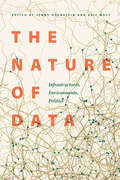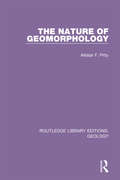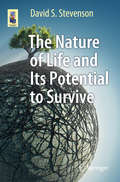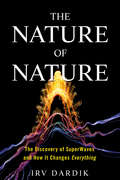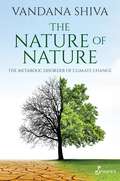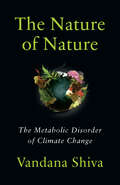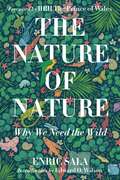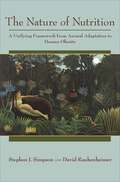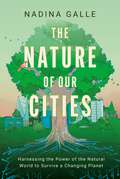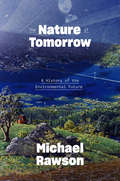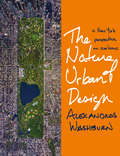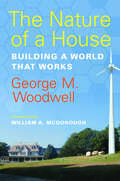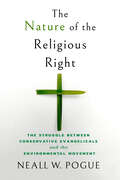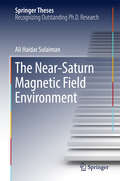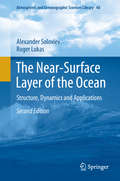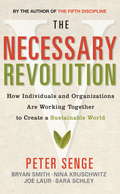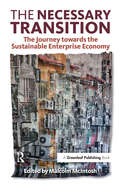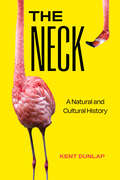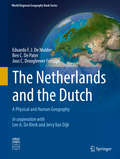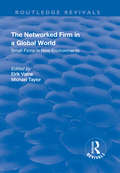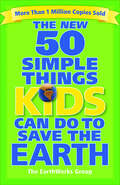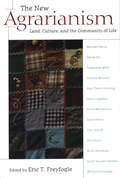- Table View
- List View
The Nature of Data: Infrastructures, Environments, Politics
by Jenny Goldstein Eric NostWhen we look at some of the most pressing issues in environmental politics today, it is hard to avoid data technologies. Big data, artificial intelligence, and data dashboards all promise &“revolutionary&” advances in the speed and scale at which governments, corporations, conservationists, and even individuals can respond to environmental challenges. By bringing together scholars from geography, anthropology, science and technology studies, and ecology, The Nature of Data explores how the digital realm is a significant site in which environmental politics are waged. This collection as a whole makes the argument that we cannot fully understand the current conjuncture in critical, global environmental politics without understanding the role of data platforms, devices, standards, and institutions. In particular, The Nature of Data addresses the contested practices of making and maintaining data infrastructure, the imaginaries produced by data infrastructures, the relations between state and civil society that data infrastructure reworks, and the conditions under which technology can further socio-ecological justice instead of re-entrenching state and capitalist power. This innovative volume presents some of the first research in this new but rapidly growing subfield that addresses the role of data infrastructures in critical environmental politics.
The Nature of Geomorphological Hazards in the Nepal Himalaya (Geoenvironmental Disaster Reduction)
by Jan Kalvoda Eva NovotnáThe book offers a wide range of research topics that are addressed with the aim of contributing to the knowledge of geomorphological hazards in the Himalaya. It is emphasized the integration of climate-driven morphogenetic and tectonic processes in the Nepal Himalaya as a substantial phenomenon of active collisional orogeny. The extreme dynamics of landform evolution in the Himalayan terranes triggers severe natural hazards and risks. Interdisciplinary research of geomorphological processes and events related to natural hazards in the Nepal Himalaya follows general efforts to reduce geoenvironmental disasters. Visual documentation is of particular importance in the conception of the book, which is intended for specialized researchers as well as students.
The Nature of Geomorphology (Routledge Library Editions: Geology #24)
by Alistair F. PittyIn this re-evaluation of the basic postulates of geomorphology, first published in 1982, Alistair Pitty examines the subject within its scientific context, arguing that coherence in geomorphology can be demonstrated despite the many apparent divergences, which should themselves be regarded as poles within a spectrum of opinion. Not least, the particularly geological and geographical aspects of geomorphology are carefully identified and explained within this coherence.
The Nature of Life and Its Potential to Survive
by David S. StevensonThis book looks at the persistence of life and how difficult it would be to annihilate life, especially a species as successful as humanity. The idea that life in general is fragile is challenged by the hardiness of microbes, which shows that astrobiology on exoplanets and other satellites must be robust and plentiful. Microbes have adapted to virtually every niche on the planet, from the deep, hot biosphere, to the frigid heights of the upper troposphere. Life, it seems, is almost indestructible. The chapters in this work examine the various scenarios that might lead to the extermination of life, and why they will almost always fail. Life's highly adaptive nature ensures that it will cling on no matter how difficult the circumstances. Scientists are increasingly probing and questioning life's true limits in, on and above the Earth, and how these limits could be pushed elsewhere in the universe. This investigation puts life in its true astronomical context, with the reader taken on a journey to illustrate life's potential and perseverance.
The Nature of Nature: The Discovery of SuperWaves and How It Changes Everything
by Irving Dardik Estee Dardik LichterWhat is everything made of? How do things change and how do they work? What is life? In The Nature of Nature, visionary scientist Irv Dardik tackles these questions by introducing his discovery of SuperWaves, a singular wave phenomenon whose design generates what we experience as matter, space, time, motion, energy, and order and chaos. Simply put, the SuperWaves principle states that the fundamental stuff of nature is waves—waves waving within waves, to be exact. Dardik challenges the rationality of accepting a priori that the universe is made of discrete particles. Instead, by drawing from his own discovery of a unique wave behavior and combining it with scientific facts, he shows that every single thing in existence—from quantum particles to entire galaxies—is waves waving in the unique pattern he calls SuperWaves. The discovery of SuperWaves and the ideas behind it, while profound, can be intuitively grasped by every reader, whether scientist or layperson. Touching on everything from quantum physics to gravity, to emergent complexity and thermodynamics, to the origins of health and disease, it shows that our health, and the health of the environment and civilization, depend upon our understanding SuperWaves. The Nature of Nature is an absorbing account that combines Dardik’s contrarian look at the history of science with philosophical discussion, his own groundbreaking research, and hope for the future.
The Nature of Nature: The Metabolic Disorder of Climate Change
by Vandana ShivaWith her inimitable mix of scholarship and activism, Vandana Shiva lays out the emergency we all face: extinction, climate havoc and the global food crisis. She lays the blame squarely at the feet of the 1%: corporations, polluters and turncoat governments. She challenges the idea that all humans are responsible for this emergency and therefore challenges the term ‘ anthropocene' . Environmental treaties intended to protect the earth have been appropriated and are now being used to create new markets in pollution and massive environmental damage. The Biodiversity Convention (1992) has been undermined and subverted by the same 1%. This is a travesty for the planet and its inhabitants. In a similar fashion, the UN Climate Convention has been turned into a marketplace for trading pollution.
The Nature of Nature: The Metabolic Disorder of Climate Change
by Vandana ShivaIn an age of climate catastrophes and extinction, we need to turn back to nature and learn, once again, how to live sustainably on planet Earth—beginning with our relationship to food.Four billion years ago, Earth was a hot, lifeless planet. Through the process of evolution, the Earth and its diversity of living organisms gradually reduced the amount of carbon in the atmosphere. About 200,000 years ago, the conditions aligned for our own species—Homo sapiens—to emerge and thrive.But what will it take to continue to survive?In The Nature of Nature, world-renowned environmental thinker and activist Vandana Shiva argues that food is the currency of life, a thread woven throughout the web of all life, indivisible from Earth and its natural systems. When this interdependence is ruptured—as it is now—the conditions for the &“metabolic disorder&” of climate change and countless other ecological imbalances come into being.Proposals put forward by Big Ag and Big Tech to solve the intertwined climate and food crises will only exacerbate both. With clarity and a detailed analysis, Shiva unpacks the false promises made by technology-oriented, lab-intensive digital agriculture, revealing the dangers posed by fake and ultra-processed foods—dangers to the environment, to increasing greenhouse gas emissions, to the health of animals, and to our health and food security.In The Nature of Nature, Shiva takes a powerful stand, arguing with urgency and passion for a food and climate future based not on techno-optimism, hallucination, and corporate delusions, but on the natural regeneration of biodiversity in partnership with the biosphere.Praise for Vandana Shiva:&“She&’s been called the &‘Gandhi of grain,&’ the &‘rock star&’ of the anti-GMO movement and an &‘eco-warrior goddess.&’ . . . Above all, [she] is a staunch believer that the food we eat matters. It makes us who we are, physically, culturally and spiritually.&”—BBC
The Nature of Nature: Why We Need the Wild
by Enric SalaIn this inspiring manifesto, an internationally renowned ecologist makes a clear case for why protecting nature is our best health insurance, and why it makes economic sense.Enric Sala wants to change the world--and in this compelling book, he shows us how. Once we appreciate how nature works, he asserts, we will understand why conservation is economically wise and essential to our survival. Here Sala, director of National Geographic's Pristine Seas project (which has succeeded in protecting more than 5 million sq km of ocean), tells the story of his scientific awakening and his transition from academia to activism--as he puts it, he was tired of writing the obituary of the ocean. His revelations are surprising, sometimes counterintuitive: More sharks signal a healthier ocean; crop diversity, not intensive monoculture farming, is the key to feeding the planet.Using fascinating examples from his expeditions and those of other scientists, Sala shows the economic wisdom of making room for nature, even as the population becomes more urbanized. In a sober epilogue, he shows how saving nature can save us all, by reversing conditions that led to the coronavirus pandemic and preventing other global catastrophes. With a foreword from Prince Charles and an introduction from E. O. Wilson, this powerful book will change the way you think about our world--and our future.
The Nature of Nature: Why We Need the Wild
by Enric SalaIn this inspiring manifesto, an internationally renowned ecologist makes a clear case for why protecting nature is our best health insurance, and why it makes economic sense.Enric Sala wants to change the world--and in this compelling book, he shows us how. Once we appreciate how nature works, he asserts, we will understand why conservation is economically wise and essential to our survival. Here Sala, director of National Geographic's Pristine Seas project (which has succeeded in protecting more than 5 million sq km of ocean), tells the story of his scientific awakening and his transition from academia to activism--as he puts it, he was tired of writing the obituary of the ocean. His revelations are surprising, sometimes counterintuitive: More sharks signal a healthier ocean; crop diversity, not intensive monoculture farming, is the key to feeding the planet.Using fascinating examples from his expeditions and those of other scientists, Sala shows the economic wisdom of making room for nature, even as the population becomes more urbanized. In a sober epilogue, he shows how saving nature can save us all, by reversing conditions that led to the coronavirus pandemic and preventing other global catastrophes. With a foreword from Prince Charles and an introduction from E. O. Wilson, this powerful book will change the way you think about our world--and our future.
The Nature of Nutrition: A Unifying Framework from Animal Adaptation to Human Obesity
by David Raubenheimer Stephen J. SimpsonThe first book to address nutrition's complex role in biologyNutrition has long been considered more the domain of medicine and agriculture than of the biological sciences, yet it touches and shapes all aspects of the natural world. The need for nutrients determines whether wild animals thrive, how populations evolve and decline, and how ecological communities are structured. The Nature of Nutrition is the first book to address nutrition's enormously complex role in biology, both at the level of individual organisms and in their broader ecological interactions.Stephen Simpson and David Raubenheimer provide a comprehensive theoretical approach to the analysis of nutrition—the Geometric Framework. They show how it can help us to understand the links between nutrition and the biology of individual animals, including the physiological mechanisms that determine the nutritional interactions of the animal with its environment, and the consequences of these interactions in terms of health, immune responses, and lifespan. Simpson and Raubenheimer explain how these effects translate into the collective behavior of groups and societies, and in turn influence food webs and the structure of ecosystems. Then they demonstrate how the Geometric Framework can be used to tackle issues in applied nutrition, such as the problem of optimizing diets for livestock and endangered species, and how it can also help to address the epidemic of human obesity and metabolic disease.Drawing on a wealth of examples from slime molds to humans, The Nature of Nutrition has important applications in ecology, evolution, and physiology, and offers promising solutions for human health, conservation, and agriculture.
The Nature of Our Cities: Harnessing the Power of the Natural World to Survive a Changing Planet
by Nadina GalleIn the tradition of Elizabeth Kolbert and Michael Pollan, The Nature of Our Cities is a stirring exploration of how innovators from around the world are combining urban nature with emerging technologies, protecting the planet’s cities from the effects of climate change and safeguarding the health of their inhabitants.We live in an age when humanity spends 90% of its time indoors, yet the nature around us—especially in America’s cities—has never been more vital. This distancing from nature has sparked crises in mental health, longevity, and hope for the next generation, while also heightening the risks we face from historic floods, heatwaves, and wildfires. Indeed, embracing nature holds untapped potential to strengthen and fortify our cities, suburbs, and towns, providing solutions spanning flood preparation, wildfire management, and promoting longevity. As ecological engineer Dr. Nadina Galle shows in The Nature of Our Cities nature is our most critical infrastructure for tackling the climate crisis. It just needs a little help. A fellow at MIT’s Senseable City Lab and selected for Forbes’ 30 under 30 list, Galle is at the forefront of the growing movement to fuse nature and technology for urban resilience. In THE NATURE OF OUR CITIES, she embarks on a journey as fascinating as it is pressing, showing how scientists and citizens from around the world are harnessing emerging technologies to unlock the power of the natural world to save their cities, a phenomenon she calls the “Internet of Nature.” Traveling the globe, Galle examines how urban nature, long an afterthought for many, actually points the way toward a more sustainable future. She reveals how technology can help nature navigate this precarious moment with modern advances such as:Laser-mapping that identifies at-risk neighborhoods to fight deadly health disparitiesA.I.-powered robots that prevent wildfires from reaching urban areasIntelligent water gardens that protect cities from floods and hurricanesAdvanced sensors that achieve 99% tree survival in dry, hot summers Optimistic in spirit yet pragmatic in approach, Galle writes persuasively that the future of urban life depends on balancing the natural world with the technology that can help sustain it. By turns clear-eyed and lyrical, THE NATURE OF OUR CITIES marks the emergence of an invigorating, prescient new talent in nature writing.
The Nature of Tomorrow: A History of the Environmental Future
by Michael RawsonAn examination of how Western visions of endless future growth have contributed to the global environmental crisis &“This book does something that is worth doing and that no other scholarly book I know of comes close to doing: tracing the history of imagined environmental futures in the Western world.&”—William Meyer, Colgate University For centuries, the West has produced stories about the future in which humans use advanced science and technology to transform the earth. Michael Rawson uses a wide range of works that include Francis Bacon&’s New Atlantis, the science fiction novels of Jules Verne, and even the speculations of think tanks like the RAND Corporation to reveal the environmental paradox at the heart of these narratives: the single-minded expectation of unlimited growth on a finite planet. Rawson shows how these stories, which have long pervaded Western dreams about the future, have helped to enable an unprecedentedly abundant and technology-driven lifestyle for some while bringing the threat of environmental disaster to all. Adapting to ecological realities, he argues, hinges on the ability to create new visions of tomorrow that decouple growth from the idea of progress.
The Nature of Urban Design: A New York Perspective on Resilience
by Alexandros WashburnThe best cities become an ingrained part of their residents' identities. Urban design is the key to this process, but all too often, citizens abandon it to professionals, unable to see a way to express what they love and value in their own neighborhoods. New in paperback, this visually rich book by Alexandros Washburn, former Chief Urban Designer of the New York Department of City Planning, redefines urban design. His book empowers urbanites and lays the foundations for a new approach to design that will help cities to prosper in an uncertain future. He asks his readers to consider how cities shape communities, for it is the strength of our communities, he argues, that will determine how we respond to crises like Hurricane Sandy, whose floodwaters he watched from his home in Red Hook, Brooklyn. Washburn draws heavily on his experience within the New York City planning system while highlighting forward-thinking developments in cities around the world. He grounds his book in the realities of political and financial challenges that hasten or hinder even the most beautiful designs. By discussing projects like the High Line and the Harlem Children's Zone as well as examples from Seoul to Singapore, he explores the nuances of the urban design process while emphasizing the importance of individuals with the drive to make a difference in their city. Throughout the book, Washburn shows how a well-designed city can be the most efficient, equitable, safe, and enriching place on earth. The Nature of Urban Design provides a framework for participating in the process of change and will inspire and inform anyone who cares about cities.
The Nature of a House: Building a World that Works
by George M. WoodwellIs it possible for a group of the world's most respected environmental scientists to truly practice what they preach? Can their expertise in climate change help them in transforming an old house and its nine acres into their new office building and campus--a building that is as energy efficient as possible, uses local materials, and generates all of the energy it consumes? In this candid, charming, and informative book, the director of the renowned Woods Hole Research Center tells a story that will interest anyone who has ever thought about doing a "green" rehab, has tried to build green, or just wonders what's actually possible. The Woods Hole Research Center is an international leader in identifying the causes and consequences of environmental change. When the WHRC needed a new administration building, its scientists and staff decided that the building should utilize "state-of-the-shelf" green building techniques and materials. However, the new office had to conform with the laws and building codes of the time, and with materials that were then available--no matter how frustrating these requirements were to the resident scientists and contractors. The author, George M. Woodwell, founder of the WHRC, was intimately involved in the design and construction of the Gilman Ordway Campus, which was completed in 2003. He details the challenges they faced, but also puts the building in a larger context, not only within the work of the Center and the tradition of Woods Hole, but in the global need to minimize our carbon emissions and overall environmental impact. Building a world that works requires rethinking how we design, reuse, and live in the built environment while preserving the functional integrity of the landscape.
The Nature of the Religious Right: The Struggle between Conservative Evangelicals and the Environmental Movement
by Neall W. PogueIn The Nature of the Religious Right, Neall W. Pogue examines how white conservative evangelical Christians became a political force known for hostility toward environmental legislation. Before the 1990s, this group used ideas of nature to help construct the religious right movement while developing theologically based, eco-friendly philosophies that can be described as Christian environmental stewardship. On the twentieth anniversary of Earth Day in 1990, members of this conservative evangelical community tried to turn their eco-friendly philosophies into action. Yet this attempt was overwhelmed by a growing number in the leadership who made anti-environmentalism the accepted position through public ridicule, conspiracy theories, and cherry-picked science.Through analysis of rhetoric, political expediency, and theological imperatives, The Nature of the Religious Right explains how ideas of nature played a role in constructing the conservative evangelical political movement, why Christian environmental stewardship was supported by members of the community for so long, and why they turned against it so decidedly beginning in the 1990s.
The Near-Saturn Magnetic Field Environment
by Ali Haidar SulaimanThis thesis focuses on the very high Mach number shock wave that is located sunward of Saturn's strong magnetic field in the continuous high-speed flow of charged particles from the Sun (the solar wind). The author exploits the fact that the Cassini spacecraft is the only orbiter in a unique parameter regime, far different from the more familiar near-Earth space, to provide in-situ insights into the unreachable exotic regime of supernova remnants. This thesis bridges the gap between shock physics in the Solar System and the physics of ultra-high Mach number shocks around the remnants of supernova explosions, since to date research into the latter has been restricted to theory, remote observations, and simulations.
The Near-Surface Layer of the Ocean
by Alexander Soloviev Roger LukasThe rationale for publishing a second edition of this monograph is that this area of research continues to show remarkable advancement. The new generation of synthetic aperture radar satellites has provided unprecedented spatial resolution of sea surface features. In addition, satellites to measure sea surface salinity have been launched. Computational fluid dynamics models open new opportunities in understanding the processes in the near-surface layer of the ocean and their visibility from space. Passive acoustic methods for monitoring short surface waves have significantly progressed. Of importance for climate research, processes in the near-surface layer of the ocean contribute to errors in satellite estimates of sea surface temperature trends. Due to growing applications of near-surface science, it is anticipated that more students will be trained in this area of research. Therefore this second edition of the monograph is closer to a textbook format.
The Nebraska Winter of 1948-49: Stories of Survival (Disaster)
by Barry SeegebarthIn 1948-49, Nebraska experienced a winter like never before. Brutal cold, unbearable winds and record snowfall made roads impassable and life difficult for locals. Farmers and ranchers struggled with hunger due to a dwindling supply of coal and food. The governor requested federal aid, and the U.S. Air Force dropped bales of hay into pastures for animals. Many locals perished in the weather, and icy roads forced the state to redesign and rebuild highways. Author Barry Seegebarth details the tragedy and courage of the Nebraska winter of 1948.
The Necessary Revolution: How Individuals and Organizations are Working Together to Create a Sustainable World
by Bryan Smith Peter M. Senge Nina Kruschwitz Joe Laur Sara SchleyThe Necessary Revolution is a book about the end of The Industrial Age Bubble the take, make, waste way of thinking that has dominated the developed world for the past 200 years. It is also a book about a new era emerging in which companies are beginning to recognise the larger systems in which they operate (environmental, social, and economic) and integrate these into their core strategies. Imagine a world in which the excess energy from one business would be used to heat another. A world in which environmentally sound products and processes would be more cost effective than wasteful ones. A world in which corporations like BP, Nike, Coca-Cola, and countless others are forming partnerships with environmental and social justice NGOs to ensure better stewardship of the earth and better livelihoods in the developing world. Now, stop imagining that world is already emerging. We must act together now.
The Necessary Transition: The Journey towards the Sustainable Enterprise Economy
by Malcolm McIntoshLife on Earth for humanity and our ecosystems is at a point of great change. There is much to be learnt about previous great disruptions. The key words are *adaptation* and *transformation*. Most international companies operate across multiple social and environmental geographies, so they know this intellectual and practical landscape. And for many governments the challenges of social and environmental justice are also paramount – not least because equitable societies are best for business, and best for human well-being.The Necessary Transition addresses the many transitions taking place around the world: from high- to low-carbon economies, from gross inequality to egalitarianism, from massive human rights abuses to socially just societies, and from high corruption to societies with high social cohesion and integrity.The book brings together leading international researchers and practitioners to share their knowledge and expertise, and offers answers to many of the pressing questions that must be addressed in the journey towards a sustainable enterprise economy – an absolutely necessary transition for humanity.Contributors include: Sara Parkin, Founder-Director and Trustee of the UK's Forum for the Future; Bill Champion, Managing Director, Rio Tinto Coal Australia; and Mark Swilling, co-author of "Just Transitions" and Academic Director of the Sustainability Institute, South Africa.The key question is: "Is a transition to a sustainable future possible within the logic of conventional capitalism and 20th-century models of development?" This book provides radical perspectives from varying entry points and is essential reading for academics and practitioners interested in how we plan, speed and scale such necessary transitions.
The Neck: A Natural and Cultural History
by Kent DunlapA 300-million-year tour of the prominent role of the neck in animal evolution and human culture. Humans give a lot of attention to the neck. We decorate it with jewelry and ties, kiss it passionately, and use it to express ourselves in word and song. Yet, at the neck, people have also shackled their prisoners, executed their opponents, and slain their victims. Beyond the drama of human culture, animals have evolved their necks into a staggering variety of shapes and uses vital to their lifestyles. The Neck delves into evolutionary time to solve a living paradox—why is our neck so central to our survival and culture, but so vulnerable to injury and disease? Biologist Kent Dunlap shows how the neck's vulnerability is not simply an unfortunate quirk of evolution. Its weaknesses are intimately connected to the vessels, pipes, and glands that make it so vital to existence. Fun and far-reaching, The Neck explores the diversity of forms and functions of the neck in humans and other animals and shows how this small anatomical transition zone has been a locus of incredible evolutionary and cultural creativity.
The Netherlands and the Dutch: A Physical and Human Geography (World Regional Geography Book Series)
by Eduardo F. De Mulder Ben C. De Pater Joos C. Droogleever Fortuijn Len A. De Klerk Jerry Van DijkThis book presents a geographical survey of the Netherlands, reviewing recent and historic developments that made the nation. It is a relatively wealthy country and the Dutch belong to the happiest and healthiest on earth. But these qualities are not evenly spread over the country. The urban agglomeration of Randstad Holland in the west hosts most of the nation’s capital and young, well-educated people whereas older and less-educated people are concentrated in the peripheral areas in the north, east and south. Interactions between physical and human geographical aspects of the Netherlands are described quite extensively. Its position on one of Europe’s most prominent deltas, its abundance of energy resources and the course of history have all contributed to its present national position and international networks. But early and recent Dutch have also shaped this country. They reclaimed lakes and shallow seas, protected the lowlands against floods, re-allotted land parcels and designed and developed urban areas. Besides its focus on water-related topics, the book also covers social and cultural aspects. The book also discusses future challenges and offers scenarios for solutions. This is a book for those interested in a wide variety of recent aspects of the geography of the Netherlands described in a historical context. It appeals to students and researchers of many disciplines in geography, urban and landscape planning, water management, history and cultural studies.
The Networked Firm in a Global World: Small Firms in New Environments (Routledge Revivals)
by Michael Taylor Eirik VatneThis title was first published in 2000. Illustrated by a wide range of international case studies, this volume elaborates, extends and critiques one of the key models of local growth, which emphasizes learning, networking and 'embeddedness' in relation to the role of small and medium-sized firms (SMEs). In doing so, it provides a comprehensive understanding of the changing role of SMEs in an era of globalization.
The New 50 Simple Things Kids Can Do to Save the Earth
by Sophie Javna EarthWorks GroupIn The New 50 Simple Things Kids Can Do to Save the Earth, Sophie and John have revised the original best-selling book for a concerned and vibrant Web 2.0 youth market. It's easy-to-do and kid-friendly projects show that kids can make a difference, and each chapter is packed with tons of links to groups and resources. What makes this book stand out, though, is that it doesn't just inform kids, it encourages them to make a difference by providing them, their friends and their families the tools to take action.Together, John and Sophie enlighten, educate, and encourage our children with easy and smart ways to save the earth. Pretty darn cool, huh? We thought so. What you can do: Order now and help save the only earth we've got.Mother Earth needs our help now.
The New Agrarianism: Land, Culture, and the Community of Life
by Eric T. FreyfogleThe engaging writings gathered in this new book explore an important but little-publicized movement in American culture -- the marked resurgence of agrarian practices and values in rural areas, suburbs, and even cities. It is a movement that in widely varied ways is attempting to strengthen society's roots in the land while bringing greater health to families, neighborhoods, and communities. The New Agrarianism vividly displays the movement's breadth and vigor, with selections by such award-winning writers as Wendell Berry, William Kittredge, Stephanie Mills, David Orr, Scott Russell Sanders, and Donald Worster. As editor Eric Freyfogle observes in his introduction, agrarianism is properly conceived in broad terms, as reaching beyond food production to include a wide constellation of ideals, loyalties, sentiments, and hopes. It is a temperament and a moral orientation as well as a suite of diverse economic practices -- all based on the insistent truth that people everywhere are part of the land community, as dependent as other life on its fertility and just as shaped by its mysteries and possibilities. The writings included here have been chosen for their engaging narratives as well as their depiction of the New Agrarianism's broad scope. Many of the selections illustrate agrarian practitioners in action, while other selections offer pointed critiques of contemporary American culture and its market-driven, resource-depleting competitiveness. Together, they reveal what Freyfogle identifies as the heart and soul of the New Agrarianism: its yearning to regain society's connections to the land and its quest to help craft a more land-based and enduring set of shared values. The New Agrarianism offers a compelling vision of this hopeful new way of living. It is an essential book for social critics, community activists, organic gardeners, conservationists, and all those seeking to forge sustaining ties with the entire community of life.
